Have you ever thought that one day in the future, cars will no longer need a steering wheel to operate freely? Perhaps it seems incredible today, but it has indeed happened. In 1996, it was just a research topic for a few people in the industry, but today it has become a component of a mass-produced car, and this car has been officially unveiled in China. Maybe in a few months, you will be able to take it home from the showroom.
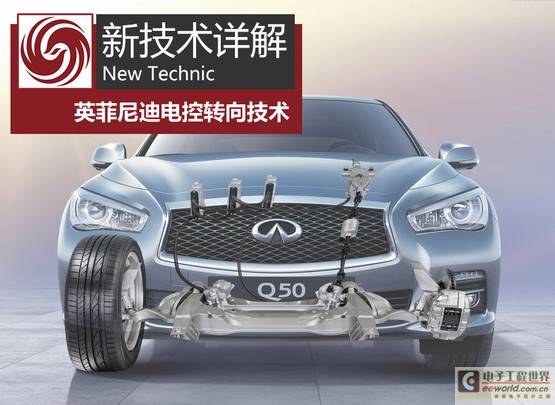
Today's technical explanation is about Infiniti's latest generation mid-size sports luxury sedan Q50, which is the successor of the Infiniti G series currently on sale in China. This car is an excellent platform for Infiniti to demonstrate its technology research and development capabilities, because it will be the world's first mass-produced car equipped with electronic steering technology.
What is electric steering technology? It is actually an application of wire control technology in automotive products. The core of wire control technology is to use electronic signals as carriers and wires as channels to transmit instructions to transmit human intentions to actuators, thereby avoiding complex mechanical transmission. The goal of wire control technology is to replace traditional mechanical transmission with wires, thereby achieving multiple goals such as weight reduction, efficiency improvement, and more intelligent control functions.

Wire control systems have long been used in aviation and navigation, such as aircraft wing control and ship rudder control, but this is the first time they have been used in civilian commercial vehicles, so this is the biggest breakthrough of the Infiniti Q50.
The so-called electronic steering system means that there is no rigid mechanical connection between the front wheel steering system and the steering wheel. The steering angle and speed of the wheel are calculated by the computer according to the driving conditions and the driver's intention to turn the steering wheel, and the computer controls the steering gear to achieve the control purpose. This means that people are just issuing instructions, and it is no longer the steering wheel in the hands of the driver that really makes the car execute the steering intention, but the computer on the car.

Drive-by-wire technology in the automotive industry
In the automotive field, the first car to realize the application of wire control technology was the Mercedes-Benz F200 concept car. In 1996, Mercedes-Benz released this super concept car and triggered a great craze in the field of wire control technology among major manufacturers. Mercedes-Benz has been engaged in the research of wire control technology since 1990. The advent of F200 heralded a breakthrough success in the application of wire control technology in vehicles. However, only part of the F200's fantastic technology at the time was transferred to mass-produced models. Mercedes-Benz has not yet put the wire control technology into mass production.

The core of the Wire-contol technology proposed on the Mercedes-Benz F200 is to eliminate the steering wheel, steering column, pedals, brake oil pipes and other equipment, and all instructions are transmitted through wires. It is for this reason that the F200 no longer needs any mechanical structure. In theory, it can achieve various ways to operate acceleration, braking and steering.
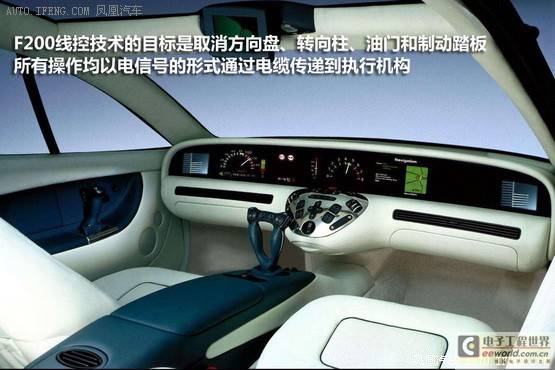
For example, the solution adopted by the F200 at that time was that the driver controlled all the movements of the car body by operating the side joysticks installed on the inside of the door and the center console. Moving the joystick left and right will steer the car, while pulling the joystick back will brake and pushing it forward will accelerate the car. This operation seems quite avant-garde even today, but perhaps today, we would prefer to use a touch screen to control the way the car moves. Isn't it cool? Unfortunately, this unrestrained idea is not impossible to realize, but it can only be played on concept cars.
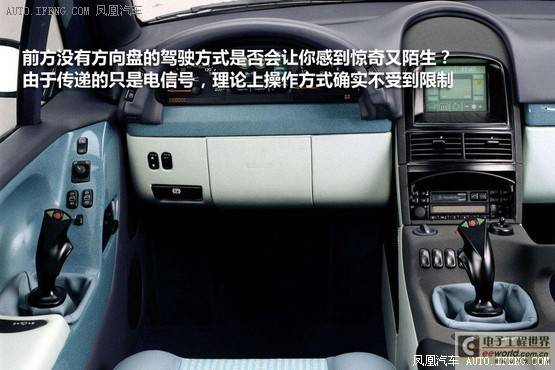
It can be said that the Mercedes-Benz F200 concept car released in 1996 provided a good starting point for the wire control technology developed by many manufacturers later. However, in the current automobile society, cars like the F200 that use all-wire control technology will almost never be mass-produced. This is because this operation method that abandons the steering wheel, accelerator, and brake pedal requires relevant legislative support and driver training from scratch. In short, it is still very difficult to promote the use of this technology in the automotive industry.
Therefore, only a few manufacturers such as Mercedes-Benz and BMW have conducted experiments on concept cars as a discussion of future automotive technology. In the field of civilian cars, our drivers still want relatively traditional and familiar operation methods. In this regard, Infiniti Q50 is the first case of perfectly integrating wire control technology based on traditional operation.
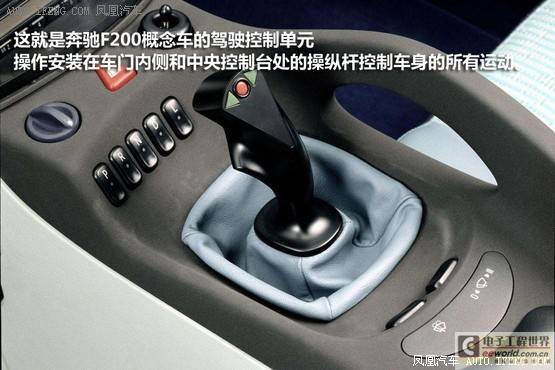
The Direct Adaptive Steering (DAS) technology on the Infiniti Q50 has the following structural features: the lower end of the steering wheel is connected to the sensor and simulator, which is responsible for sensing the driver's control and simulating feedback; the steering intention obtained from the driver will be transmitted to the ECU control unit, and three groups of ECU units are responsible for receiving and processing electrical signals; further down is the steering angle/force sensor connected to the vehicle steering system, which is responsible for executing the steering commands issued by the ECU, and receiving information fed back from the ground for the ECU system to make more accurate judgments.
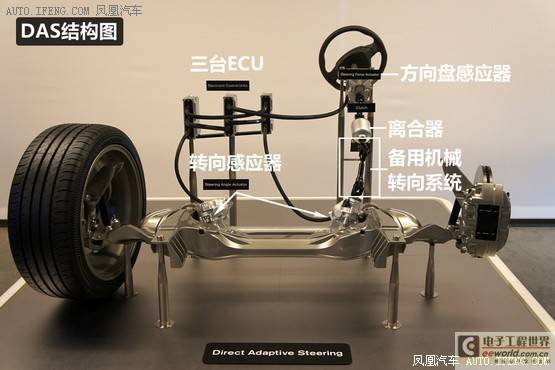
Although the Q50 also retains the traditional steering wheel and steering column in the body structure, the mechanical connection between the two is normally separated by a clutch, and there is no mechanical force transmission at all. Therefore, the force applied to the wheels by the road surface will not be directly transmitted to the steering wheel. The steering wheel's control reaction force is generated by the motor on the steering column that is responsible for providing reaction force to the steering wheel. This helps to filter out the impact of the road on the driver while driving, and is especially helpful in reducing distractions when driving at high speeds, especially panic caused by sudden changes in road conditions. This means that the Q50 will be more relaxed and comfortable when driving.
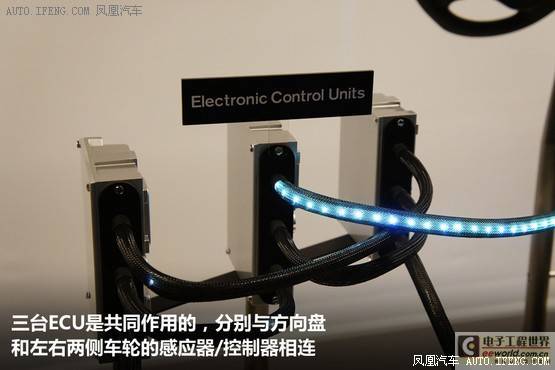
If you want to get a lot of driving pleasure, then the Q50's electronic steering system will provide you with a wealth of steering adjustment items, and this can not only change the steering wheel feedback strength, but since the ECU has the highest say here, it can even provide you with a distinctive driving experience by changing the steering wheel speed ratio, feedback speed and many other ways.

How reliable is it?
Although the control-by-wire technology is not a new technology that has been introduced recently, it is the first time it has been applied to civilian vehicles, so consumers will definitely have some doubts about its reliability. Infiniti's R&D personnel have long considered this issue and provided a multi-insurance safety guarantee plan.
First of all, Infiniti's DAS has a total of three ECU units, and these three ECUs are interoperable and can monitor each other. If one of the ECUs fails, it can still be accurately controlled based on the processing results of the other two normal ECUs. Moreover, when the three ECUs are coordinated, if one of them fails, it is also very simple to troubleshoot and repair.
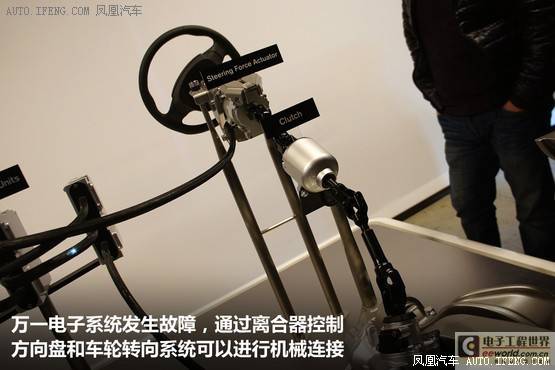
In addition to the ECU unit, there are two groups of electric motors that perform steering movements. Even if one of the groups fails, the other group can continue to control the vehicle's steering movements. It can be said that after numerous safeguards, the Infiniti Q50's electronic steering technology has sufficient safety backup.
Some people may ask, since the Q50 already has such a complete safety system, why does it still retain the traditional mechanical structure? The main reason is of course not excluding legislation. Many countries require that the steering wheel and the steering system must have a mechanical connection. In addition, as a final safety guarantee, once the ECU and motor fail, the current will flow through the connection clutch, thereby restoring the mechanical connection between the steering wheel and the lower part of the steering column, so that the driver can still continue to control the vehicle even if the electronic system fails completely.

During the Guangzhou Auto Show, Infiniti Q50 introduced the 2.0T model to China for the first time, indicating that Infiniti will soon conquer the world with the latest technology. At the same time, one of my colleagues went to the United States to conduct an in-depth test drive report on the Q50. Next, let's see how he described the DAS electronic steering system of the Infiniti Q50.
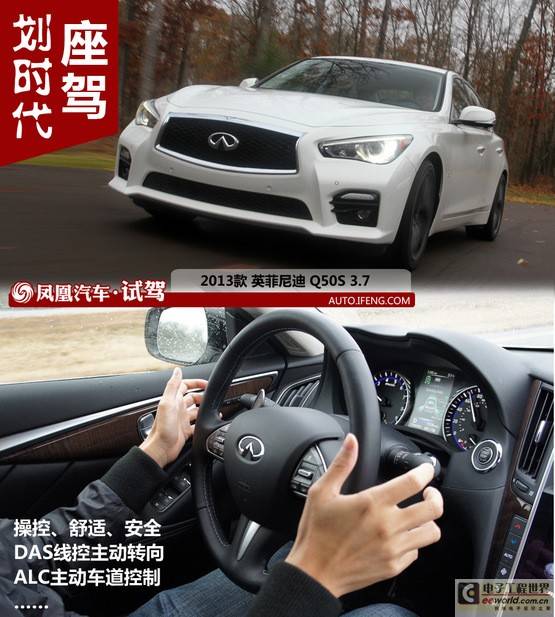
Because the active steering by wire is ultimately controlled by a computer, the steering angle, steering speed and force feedback can all be changed. The simplest is the steering force. The force transmitted to the steering wheel through the simulator can be switched between light, standard and heavy. In sports mode, the default is a heavier force, and this change is very obvious.
The body's reaction speed to steering wheel control can also be adjusted, and there are three different effects: fast, standard, and slow. Of course, these self-adjustable options must be performed in the personalized setting mode. The difference in reaction speed can be best experienced in the control experience on the field. The standard mode is similar to the one without DAS, while in the fast mode, the body's reaction to steering is obviously much more direct and rapid. Basically, as soon as the steering wheel is turned, the body immediately makes the corresponding action. People who are exposed to this mode for the first time really need to adapt.
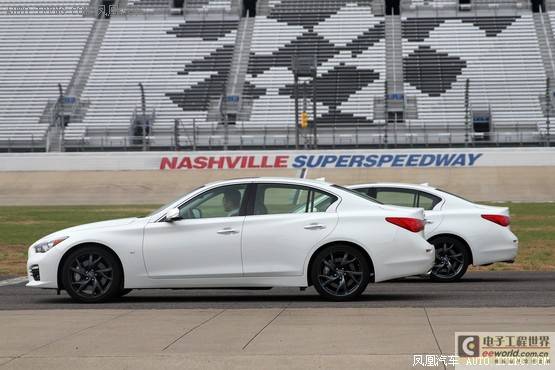
Especially in the fast response mode, the steering ratio of the system becomes tighter, which means that the steering wheel needs to turn a smaller angle to make the same angle. This also makes the Infiniti Q50 more aggressive in handling. For example, in some U-turns, vehicles without DAS or vehicles with DAS that are not in fast/sport mode need to turn the steering wheel more than half a circle, and both hands need to be used to steer alternately; while vehicles with DAS in fast/sport mode only need to turn a little more than 90 degrees, and both hands do not need to leave the steering wheel, which significantly reduces the range of operation when turning.
Steering force and speed are one aspect of control, and some people care about the road feel the steering wheel conveys to the driver. At this time, different voices will be produced, because the DAS of the Infiniti Q50 is simulated by computer for road feedback, so it will definitely not have the real sense of machinery, or it is filtered, so some people will feel uncomfortable, while others don't care. In my opinion, as long as it is not used to compete on the track, whether the road feel is real or not does not make a difference from the perspective of ordinary drivers.

However, we have to mention here another idea that the manufacturer had when developing the DAS system. Because there is no mechanical connection between the steering wheel and the wheels, the feedback from the road is also simulated. Therefore, the vibration of the steering wheel caused by road bumps can be minimized during daily driving, allowing the vehicle to have better straight-line driving stability and be more comfortable during long-distance driving.
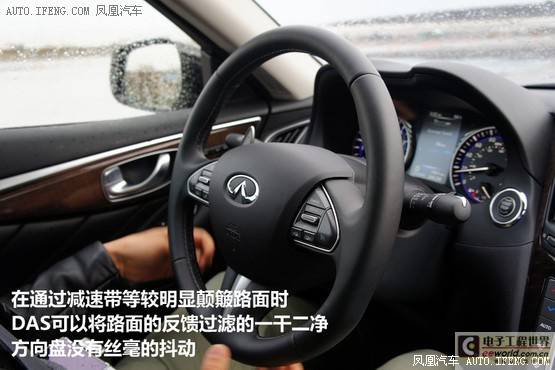
Using extreme situations to verify is the most effective method. The most common thing we encounter in daily life is speed bumps. When a vehicle passes through speed bumps, the steering wheel will definitely shake significantly because the wheels press against obstacles. At this time, we will subconsciously hold the steering wheel tightly to prevent loss of control. On the Infiniti Q50 equipped with DAS, the system completely filters out the feedback of such ground bumps, and the steering wheel does not shake at all in the hand, which is really surprising and indeed more comfortable.
Active Lane Control
The advantages of wire-controlled active steering are not limited to this. With the help of this technology, active safety can also be improved. Therefore, Infiniti Q50 has another world first, Active Lane Control (ALC). You may say that this technology is also available in other models and it cannot be considered a first. Indeed, from the literal meaning and basic principles, this technology already exists, such as Audi, BMW, Mercedes-Benz, etc., but the use effect is different.
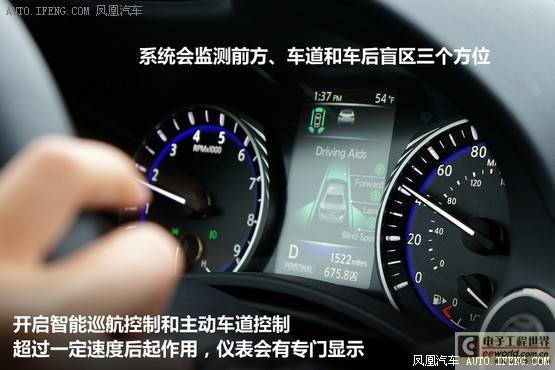
The basic principle of the Infiniti Q50's ALC is to collect the distance between the vehicle and the lane line through the camera outside the vehicle body to reduce the risk of lane deviation. However, the difference with other models is that the intervention and control of the vehicle direction is more precise and gentle with DAS. If conditions permit, the vehicle will always follow the lane without controlling the steering wheel.
We experienced the effect of this system on the highway in the United States. The road has clear dividing lines, but it was raining all day and the road surface was slippery. At a speed of 70mph (approximately equivalent to 112km/h), after turning on ALC, the vehicle can automatically stay in the center of the lane. If it deviates to one side, the wheel steering angle will be adjusted very slightly to bring the vehicle back to the center of the lane. During the whole process, the vehicle dynamics are stable and the steering is soft and smooth.
Because DAS is actively working, the steering wheel does not have any rotation or force feedback at this time. Only when the direction deflection is large, there will be slight feedback to prompt the driver. This feeling is the same as the road feel mentioned above. It will make people feel strange at first. The car turns by itself without moving the hands. It feels a bit out of control. If you don’t have confidence in the new system, you may not want to try it.
This also shows that any new technology will make people resist it at the beginning of its application. After all, it is very different from the concept of transmission or the habits formed over a long period of time, not to mention handing over the control of the vehicle to the computer, just like some scenes in science fiction movies. Maybe it will be like this in the future, but now we still need to adapt. In general, I personally have a good impression of this system. Driving the Infiniti Q50 for long distances must be much easier.
Previous article:Delphi uses Labview and CompactRIO to develop power steering simulation feedback system
Next article:Infiniti steer-by-wire system
- Popular Resources
- Popular amplifiers
- Car key in the left hand, liveness detection radar in the right hand, UWB is imperative for cars!
- After a decade of rapid development, domestic CIS has entered the market
- Aegis Dagger Battery + Thor EM-i Super Hybrid, Geely New Energy has thrown out two "king bombs"
- A brief discussion on functional safety - fault, error, and failure
- In the smart car 2.0 cycle, these core industry chains are facing major opportunities!
- The United States and Japan are developing new batteries. CATL faces challenges? How should China's new energy battery industry respond?
- Murata launches high-precision 6-axis inertial sensor for automobiles
- Ford patents pre-charge alarm to help save costs and respond to emergencies
- New real-time microcontroller system from Texas Instruments enables smarter processing in automotive and industrial applications
- Innolux's intelligent steer-by-wire solution makes cars smarter and safer
- 8051 MCU - Parity Check
- How to efficiently balance the sensitivity of tactile sensing interfaces
- What should I do if the servo motor shakes? What causes the servo motor to shake quickly?
- 【Brushless Motor】Analysis of three-phase BLDC motor and sharing of two popular development boards
- Midea Industrial Technology's subsidiaries Clou Electronics and Hekang New Energy jointly appeared at the Munich Battery Energy Storage Exhibition and Solar Energy Exhibition
- Guoxin Sichen | Application of ferroelectric memory PB85RS2MC in power battery management, with a capacity of 2M
- Analysis of common faults of frequency converter
- In a head-on competition with Qualcomm, what kind of cockpit products has Intel come up with?
- Dalian Rongke's all-vanadium liquid flow battery energy storage equipment industrialization project has entered the sprint stage before production
- Allegro MicroSystems Introduces Advanced Magnetic and Inductive Position Sensing Solutions at Electronica 2024
- Car key in the left hand, liveness detection radar in the right hand, UWB is imperative for cars!
- After a decade of rapid development, domestic CIS has entered the market
- Aegis Dagger Battery + Thor EM-i Super Hybrid, Geely New Energy has thrown out two "king bombs"
- A brief discussion on functional safety - fault, error, and failure
- In the smart car 2.0 cycle, these core industry chains are facing major opportunities!
- The United States and Japan are developing new batteries. CATL faces challenges? How should China's new energy battery industry respond?
- Murata launches high-precision 6-axis inertial sensor for automobiles
- Ford patents pre-charge alarm to help save costs and respond to emergencies
- New real-time microcontroller system from Texas Instruments enables smarter processing in automotive and industrial applications
- For NPN tubes, the c and e poles of U(br)ceo are both N-type, so where does the reverse statement come from?
- AWR1642: Add I2C driver support to the existing mmWave SDK demo
- 【GD32E503 Review】+ Littlefs Porting
- Solution to TL570x-EVM-A2 development board device node operation not permitted
- National Technology N32 MCU RF Resource Library (official, practical information)
- Raspberry Pi Pico Windows Development Environment - Compile under Visual Studio Code...
- Power circuit problem
- View Circuit-ADC and System (1)
- Teach you to understand the role of resistors in circuits
- EEWORLD University Hall----High-efficiency power architecture for smart door locks, battery-free light switches and wireless sensors

 LM324KAPW
LM324KAPW











 京公网安备 11010802033920号
京公网安备 11010802033920号